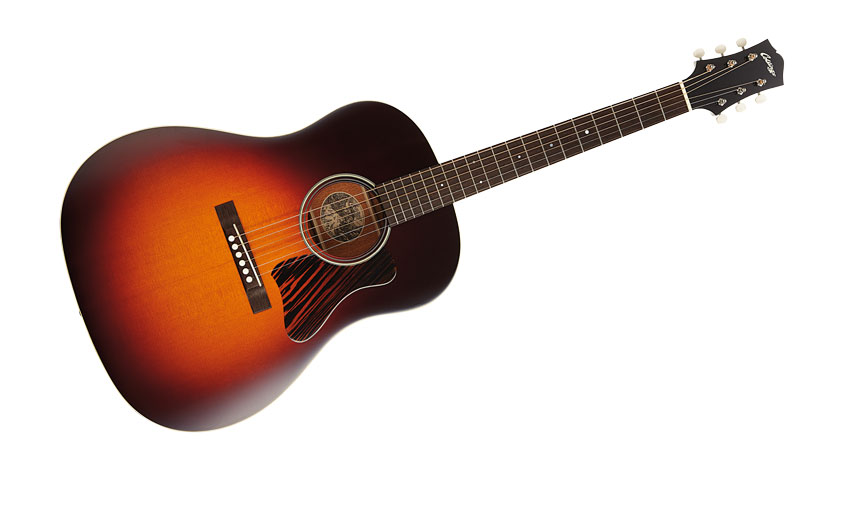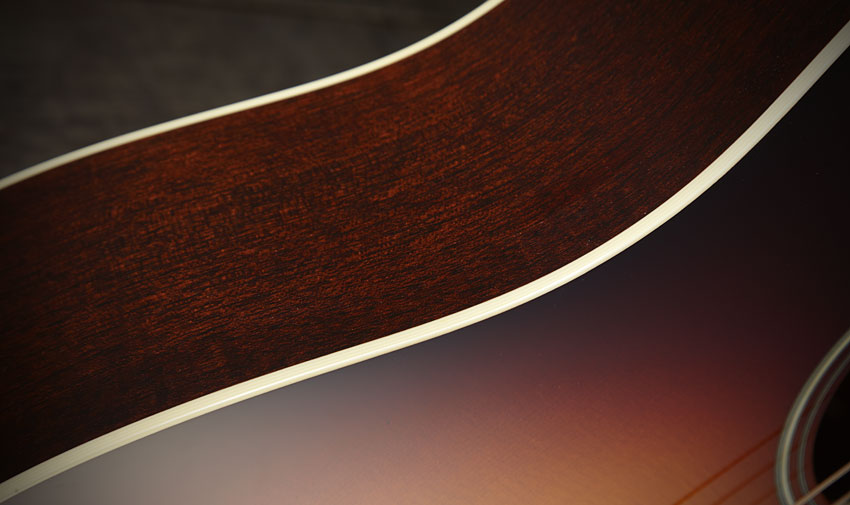MusicRadar Verdict
Simply jaw-dropping build quality and awe- inspiring modern-vintage tone, albeit at an equally arresting price.
Pros
- +
Top notch build. Almost unrivalled tones (for a new guitar).
Cons
- -
That eye-watering price.
MusicRadar's got your back

Collings CJ35

Binding
Rewind if you can to the mid 1930s when The Great Depression was at its height. Despite the bleak economic situation and the despair it caused, it coincided almost seamlessly with the steel-string acoustic's 'golden period'. It was during this pre-war period that the principle features and conventions of the modern acoustic guitar were established. They continue to define the best vintage-style flat tops to this very day.
The austerity of those times led directly to this review guitar's forebear, the Gibson J-35 (which is itself the precursor to the now legendary J-45 that's beloved of players as diverse as they are legion). The J-35 was every bit the Depression-era guitar; adornments kept to the absolute minimum to keep costs - and therefore the price - as low as possible.
Fast-forward to today and Collings Guitars of Austin, Texas, is paying homage to the J-35 with its own, inimitable take on things. The company already has the successful CJ model, but the new '35' variant strips things back, inspired directly by those pre-war, austerity specifications. Now take a look at that price again. Austerity: is somebody having a laugh?
Simple Perfection
"The tiny details delight, for example the perfect walnut strip down the centre of the mahogany back"
There's no doubt about it, the CJ35 is utterly breathtaking. Every angle, every edge chamfer and detail is executed with the kind of meticulous precision rarely seen in guitar- making at any level. The specs might look simple on paper - spruce top, mahogany back and sides and minimal ornamentation - but the tiny details delight, for example the perfect walnut strip down the centre of the mahogany back, the unfussy yet charming body binding and rosette and the cut-through bone saddle that extends into the shoulders of the unfussy rosewood bridge.
Putting the saddle in like this isn't for everyone, it should be said. It means it needs to be glued in for a start, and makes it near impossible to install an undersaddle pickup should you want one. But boy oh boy is it beautiful.
The 'haircut'-style headstock is the standard shape on the altogether more fancy Collings CJ model, but here it's unbound and rather plain looking until you get closer and see the detail. Being unbound, it means the edges have to be absolutely flawless, both on the ebony headplate, and also where it joins the peghead itself.
It's quite possible that the majority of players looking to drop way over four grand on a slope-shoulder dread might be swayed by the regular CJ model's extra bling factor in pure visual terms. Anyone who really gets what this guitar is about tonally and historically, however, will take great delight in its understated, yet breathtaking simplicity.
Want all the hottest music and gear news, reviews, deals, features and more, direct to your inbox? Sign up here.
One of the main points of difference between the standard CJ and this 35 variant is the use of non-scalloped Adirondack spruce bracing with three tone bars (the CJ has scalloped Sitka spruce and two tone bars). It's not something you'd realise the second you pick it up, but coupled with the 24.875-inch 'short' Gibson-like scale length (standard CJs are 25.5 inches), it has a definite effect on the sound.
Before we do that, let's just stand back and look it again: the most gloriously flat gloss nitrocellulose over a big, beautiful sunburst, which contributes £515 of the £4,615 price. There's nothing austere about any of that.
Feel & Sounds
"It weighs next to nothing, and you can feel the thing vibrating the second you take it from the case"
It weighs next to nothing, and you can feel the thing vibrating the second you take it from the case. There's definitely an 'older', more forthright Americana sound emitting from this guitar than its more contemporary siblings. String separation and all-over articulation is significantly more pronounced than the new Gibson J-35 and J-45s we've played of late, which may be a good or a bad thing depending on your tastes.
The non-scalloped Adirondack bracing is said to give the guitar more dynamic headroom; it's stiffer, so while you have to put a little more effort in, you can also expect a little more back out. Delicate fingerstylists won't really get it compared with their feather- braced cedar tops, but for flatpickers with more string attack, strummers and blues-style fingerpickers, you're going to like this guitar a whole lot.
Adding real interest to that general picture in our opinion is the shorter scale length that, all else being equal, tends to warm up the midrange a touch and add an element of coherence and chewiness to chords in particular: it's one reason why Gibson J-45s sound so different from Martin dreadnoughts, and seem to be such perfect companions for singer-songwriters.
We've heard it said that a big ol' neck contributes hugely to the sound of a great acoustic, and it'd be hard to argue with that here. Collings calls this one 'vintage inspired' which means a big, rounded chunk of mahogany in the hand at the lower frets that gets deeper, but with less shoulder as you go up the neck. Coupled with the 1.75-inch nut and the wider-than-than standard string spacing at the bridge, there's plenty of room to get both pick and fingers in there. Traditionalists will love it; lovers of modern thin necks less so.
The result is a guitar that retains much of the trademark Collings canon-like projection and string separation, albeit with a palpably more - as we've already said - vintage Americana sound and response than the company's OM- or D1, for example. Astounding, clear and deep bass, too, it should be said.
In order to genuinely appreciate this guitar, you need to take some flattop history lessons, then play a bunch of J-35- and J-45-inspired guitars, including Gibson's own, of course. What that would conclude is that the quality of build, not to mention the precision and depth of the CJ35's tone are second to none. By no means a vintage clone, it sounds spectacular now, so heaven only knows what it's going to sound like with 25 years of solid playing on it.
Collings makes other guitars that will give you an easier ride; thinner necks, tops that require less right hand and so on, but if you want a borderline perfect vintage 'jumbo' for flatpicking, strumming and more spirited picking, this is it. A scarily good, once-in-a- lifetime guitar for a very lucky few.